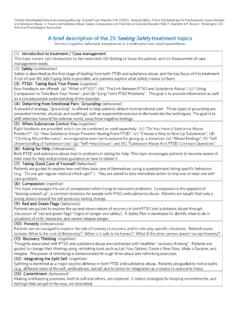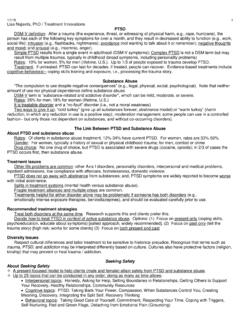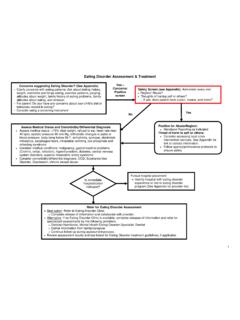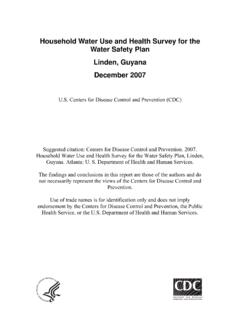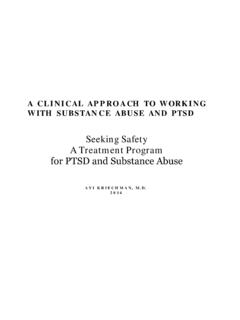Transcription of Safe Coping Skills (Part 1) - cfsslo
1 safe Coping Skills ( part 1) FROM " seeking safety : COGNITIVE-BEHAVIORAL THERAPY FOR PTSD AND SUBSTANCE ABUSE" BY LISA M. NAJAVITS, With appreciation to the Allies Program (Sacramento, CA) for formatting this safe Coping List. Guilford Press, New York. From: Najavits, seeking safety : A treatment Manual for PTSD and Substance Abuse (2002). Only for personal use (with clients); for any other use contact or 1. Ask for help-Reach out to someone safe 2. Inspire yourself-Carry something positive ( , poem), or negative (photo of friend who overdosed) 3. Leave a bad scene - When things go wrong, get out 4.
2 Persist- Never, never, never, never, never, never, never, never, never give up 5. Honesty- Secrets and lying are at the core of PTSD and substance abuse; honesty heals them 6. Cry- Let yourself cry; it will not last forever 7. Choose self-respect- Choose whatever will make you like yourself tomorrow 8. Take good care of your body- Eat right, exercise, sleep, safe sex 9. List your options- In any situation, you have choices 10. Create meaning- Remind yourself what you are living for: your children? Love? Truth? Justice? God? 11. Do the best you can with what you have- Make the most of available opportunities 12.
3 Set a boundary- Say "no" to protect yourself 13. Compassion- Listen to yourself with respect and care 14. When in doubt, do what's hardest- The most difficult path is invariably the right one 15. Talk yourself through it- Self-talk helps in difficult times 16. Imagine- Create a mental picture that helps you feel different ( , remember a safe place) 17. Notice the choice point- In slow motion, notice the exact moment when you chose a substance 18. Pace yourself- If overwhelmed, go slower; if stagnant, go faster 19. Stay safe - Do whatever you need to do to put your safety above all 20.
4 Seek understanding, not blame- Listen to your behavior; blaming prevents growth 21. If one way doesn't work, try another- As if in a maze, turn a corner and try a new path 22. Link PTSD and substance abuse- Recognize substances as an attempt to self-medicate 23. Alone is better than a bad relationship- If only treaters are safe for now, that's okay 24. Create a new story- You are the author of your life: be the hero who overcomes adversity 25. Avoid avoidable suffering- Prevent bad situations in advance 26. Ask others-Ask others if your belief is accurate 27. Get organized- You'll feel more in control with lists, "to do's" and a clean house 28.
5 Watch for danger signs- Face a problem before it becomes huge; notice red flags 29. Healing above all- Focus on what matters 30. Try something, anything- A good plan today is better than a perfect one tomorrow 31. Discovery-Find out whether your assumption is true rather than staying ''in your head" 32. Attend treatment - AA, self-help, therapy, medications, groups-anything that keeps you going 33. Create a buffer- Put something between you and danger ( , time, distance) 34. Say what you really think- You'll feel closer to others (but only do this with safe people) 35. Listen to your needs- No more neglect- really hear what you need 36.
6 Move toward your opposite- , if you are too dependent, try being more independent 37. Replay the scene- Review a negative event: what can you do differently next time? 38. Notice the cost- What is the price of substance abuse in your life? 39. Structure your day-A productive schedule keeps you on track and connected to the world 40. Set an action plan- Be specific, set a deadline, and let others know about it 41. Protect yourself- Put up a shield against destructive people, bad environments, and substances 42. Soothing talk- Talk to yourself very gently (as if to a friend or small child) safe Coping Skills ( part 2) FROM " seeking safety : COGNITIVE-BEHAVIORAL THERAPY FOR PTSD AND SUBSTANCE ABUSE" BY LISA M.
7 NAJAVITS, With appreciation to the Allies Program (Sacramento, CA) for formatting this safe Coping List. Guilford Press, New York. From: Najavits, seeking safety : A treatment Manual for PTSD and Substance Abuse (2002). Only for personal use (with clients); for any other use contact or 43. Think of the consequences- Really see the impact for tomorrow, next week, next year 44. Trust the process- Just keep moving forward; the only way out is through 45. Work the material- The more you practice and participate, the quicker the healing 46. Integrate the split self- Accept all sides of yourself; they are there for a reason 47.
8 Expect growth to feel uncomfortable- If it feels awkward or difficult you're doing it right 48. Replace destructive activities- Eat candy instead of getting high 49. Pretend you like yourself- See how different the day feels 50. Focus on now- Do what you can to make today better; don't get overwhelmed by the past or future 51. Praise yourself- Notice what you did right; this is the most powerful method of growth 52. Observe repeating patterns- Try to notice and understand your re-enactments 53. Self-nurture- Do something that you enjoy ( , take a walk, see a movie) 54.
9 Practice delay- If you can't totally prevent a self-destructive act, at least delay it as long as possible 55. Let go of destructive relationships-If it can't be fixed, detach 56. Take responsibility-Take an active, not a passive approach 57. Set a deadline-Make it happen by setting a date 58. Make a commitment- Promise yourself to do what's right to help your recovery. 59. Rethink-Think in a way that helps you feel better 60. Detach from emotional pain (grounding)- Distract, walk away, change the channel 61. Learn from experience- Seek wisdom that can help you next time 62.
10 Solve the problem- Don't take it personally when things go wrong-try to just seek a solution 63. Use kinder language- Make your language less harsh 64. Examine the evidence- Evaluate both sides of the picture 65. Plan it out- Take the time to think ahead- it's the opposite of impulsivity 66. Identify the belief- For example, shoulds, deprivation reasoning 67. Reward yourself-Find a healthy way to celebrate anything you do right 68. Create new "tapes" Literally! Take a tape recorder and record a new way of thinking to play back 69. Find rules to live by- Remember a phrase that works for you ( , "Stay real") 70.
